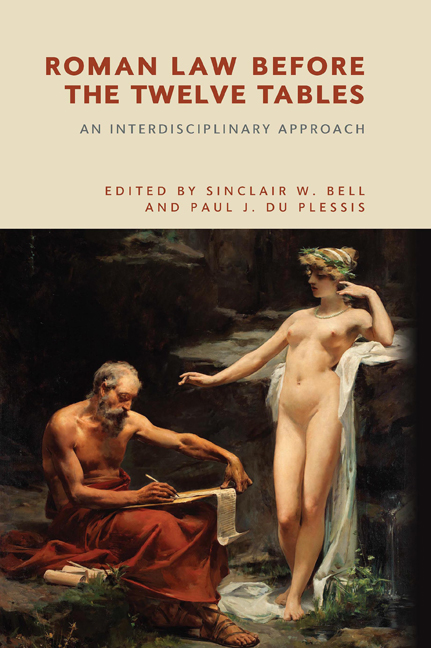Book contents
- Frontmatter
- Contents
- The Contributors
- Introduction: The Dawn of Roman Law
- Part I The Materiality of Roman Law: New Archaeological Discoveries
- 1 Roman Law in its Italic Context
- 2 Central Italian Elite Groups as Aristocratic Houses in the Ninth to Sixth Centuries BCE
- 3 Authority and Display in Sixth-Century Etruria: The Vicchio Stele
- Part II Constructing Early Roman Law: Sources and Methods
- 4 The Twelve Tables and the leges regiae: A Problem of Validity
- 5 The leges regiae in Livy: Narratological and Stylistic Strategies
- 6 The leges regiae through Tradition, Historicity and Invention: A Comparison of Historico-literary and Jurisprudential Sources
- 7 The Laws of the Kings – A View from a Distance
- 8 Beyond the Pomerium: Expansion and Legislative Authority in Archaic Rome
- Part III Roman Law in Historiography and Theory
- 9 Niebuhr and Bachofen: New Forms of Evidence on Roman History
- 10 Finding Melanesia in Ancient Rome: Mauss’ Anthropology of nexum
- Index
3 - Authority and Display in Sixth-Century Etruria: The Vicchio Stele
Published online by Cambridge University Press: 22 September 2020
- Frontmatter
- Contents
- The Contributors
- Introduction: The Dawn of Roman Law
- Part I The Materiality of Roman Law: New Archaeological Discoveries
- 1 Roman Law in its Italic Context
- 2 Central Italian Elite Groups as Aristocratic Houses in the Ninth to Sixth Centuries BCE
- 3 Authority and Display in Sixth-Century Etruria: The Vicchio Stele
- Part II Constructing Early Roman Law: Sources and Methods
- 4 The Twelve Tables and the leges regiae: A Problem of Validity
- 5 The leges regiae in Livy: Narratological and Stylistic Strategies
- 6 The leges regiae through Tradition, Historicity and Invention: A Comparison of Historico-literary and Jurisprudential Sources
- 7 The Laws of the Kings – A View from a Distance
- 8 Beyond the Pomerium: Expansion and Legislative Authority in Archaic Rome
- Part III Roman Law in Historiography and Theory
- 9 Niebuhr and Bachofen: New Forms of Evidence on Roman History
- 10 Finding Melanesia in Ancient Rome: Mauss’ Anthropology of nexum
- Index
Summary
INTRODUCTION
The discovery of an inscribed stele (Figure 3.1) at the sanctuary of Poggio Colla (Vicchio, FI) provides new information about the sanctuary and its cults and raises important questions about literacy and elite authority at the northern edge of Etruria in the Archaic Period. The stele was unearthed in 2015, during the twentyfirst and final season of excavation at the sanctuary of Poggio Colla. That final season was focused on the architecture of the acropolis sanctuary. The stele was found in a secure archaeological context, carefully placed in the front podium of a temple constructed around 500 BCE. The date of the temple provides a terminus ante quem; thus the monument was displayed in the earliest phase of occupation at the site, Phase 0, and during the sixth century BCE.
THE SANCTUARY
Poggio Colla was a hilltop sanctuary, situated at a dominant position, the junction of the broad Mugello basin and the Sieve River valley. The site controls an important route, connecting the Apennine passes and the plains of Etruria Padana with the region of Fiesole, thus providing access to and from two major areas of the Italian peninsula. The sanctuary was surrounded by extensive settlement and production areas, only a few of which have been excavated. They range from early date, Orientalising (seventh century BCE) production areas for ceramics and stone on the North-West Slope, to a Hellenistic complex for ceramic production in the Podere Funghi about a kilometre from the acropolis. The site flourished from at least the seventh century through the second century BCE, but human presence is attested even earlier, from the Holocene through the Neolithic and Middle Bronze Age, suggesting that Poggio Colla's importance as a cult centre may predate the Etruscan Period.
The acropolis sanctuary has at least four major phases of construction. The first (Phase 0), a pre-monumental phase (seventh and sixth centuries BCE), is a characteristic ‘hut village’ of the type well known in Etruria and Iron Age Italy (Phase 0). There is evidence of timber-framed oval structures, only one of which has been identified and excavated, on the south flank of the terrace (PC 21) in an area undisturbed by later construction. Evidence of occasionally preserved postholes elsewhere on the terrace suggests the existence of other structures of this type.
- Type
- Chapter
- Information
- Roman Law before the Twelve TablesAn Interdisciplinary Approach, pp. 41 - 54Publisher: Edinburgh University PressPrint publication year: 2020



